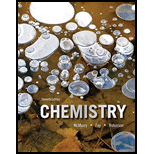
Interpretation:
The spontaneity of a process depends on several factors; one of the several factors is entropy. When the change in entropy of a process is negative, the process is said to be spontaneous.
Concept introduction:
Entropy is referred to as the 'state of disorder' of a system. Also, entropy is a measure of the energy of atoms and molecules in a process and can be defined in terms of statistical probabilities of a system or in terms of the other
When the change in entropy of a process is negative, the process is said to be spontaneous due to increase randomness of the system. When the change in entropy of a process is positive, the process is said to be non-spontaneous due to decrease in randomness of the system. The change in entropy occurs during phase transitions, precipitation reactions etc.
The change in entropy is defined as the difference between the entropies of the final and initial states:
Formula to calculate change in entropy
Given:
State A: 1 mol of
State B: 1 mol of
To determine:
- To determine which state has higher entropy in terms of probability. To determine the change in entropy
- from State A to State B.
Want to see the full answer?
Check out a sample textbook solution
Chapter 17 Solutions
Chemistry
 ChemistryChemistryISBN:9781305957404Author:Steven S. Zumdahl, Susan A. Zumdahl, Donald J. DeCostePublisher:Cengage Learning
ChemistryChemistryISBN:9781305957404Author:Steven S. Zumdahl, Susan A. Zumdahl, Donald J. DeCostePublisher:Cengage Learning ChemistryChemistryISBN:9781259911156Author:Raymond Chang Dr., Jason Overby ProfessorPublisher:McGraw-Hill Education
ChemistryChemistryISBN:9781259911156Author:Raymond Chang Dr., Jason Overby ProfessorPublisher:McGraw-Hill Education Principles of Instrumental AnalysisChemistryISBN:9781305577213Author:Douglas A. Skoog, F. James Holler, Stanley R. CrouchPublisher:Cengage Learning
Principles of Instrumental AnalysisChemistryISBN:9781305577213Author:Douglas A. Skoog, F. James Holler, Stanley R. CrouchPublisher:Cengage Learning Organic ChemistryChemistryISBN:9780078021558Author:Janice Gorzynski Smith Dr.Publisher:McGraw-Hill Education
Organic ChemistryChemistryISBN:9780078021558Author:Janice Gorzynski Smith Dr.Publisher:McGraw-Hill Education Chemistry: Principles and ReactionsChemistryISBN:9781305079373Author:William L. Masterton, Cecile N. HurleyPublisher:Cengage Learning
Chemistry: Principles and ReactionsChemistryISBN:9781305079373Author:William L. Masterton, Cecile N. HurleyPublisher:Cengage Learning Elementary Principles of Chemical Processes, Bind...ChemistryISBN:9781118431221Author:Richard M. Felder, Ronald W. Rousseau, Lisa G. BullardPublisher:WILEY
Elementary Principles of Chemical Processes, Bind...ChemistryISBN:9781118431221Author:Richard M. Felder, Ronald W. Rousseau, Lisa G. BullardPublisher:WILEY





